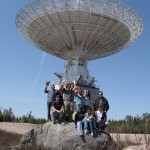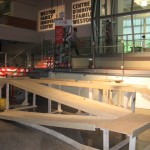03.20
Since joining the faculty in July 2006, I have taught or am teaching the following courses:
ENG 4350 Space Hardware
This is a fourth year, two-semester course for engineering and science students. It is built around a series of labs which were developed before I joined the faculty. I have been slowly modifying them and have added lecture material to review/introduce some of the concepts involved. The course currently includes two 90-minute lectures and a 3-hour lab per week. Students are assessed based on lab write-ups, assignments and quizzes. The quizzes include questions from the Basic and Advanced Amateur Radio Certification Question Bank, and I invite a RAC examiner to get the students to become certified amateur radio operators during the course. The course is most known for the final set of labs which gets the students writing code to track spacecraft with a ground station antenna. Student code is tested at first in the lab with STK simulations and then as part of a field trip to the Algonquin Radio Observatory, where we track GPS spacecraft in orbit using the 46-m dish.
More details on the course are available here. This course is hosted on the university’s Moodle server.
ENG 3330 Materials for Space Applications
This is a third year, 1-semester course given to engineering and science students. In this course, we review the launch and on-orbit conditions encountered by space equipment and discuss the relevant material properties. Computer modelling of the spacecraft structural design and materials is performed, including analysis with NX Nastran as well as environmental modelling using the ESA SPENVIS web-based tools. The course meets twice per week for a 90-minute lecture. Students are assessed based on assignments, quizzes, a small vibration test and a final exam. New in Winter 2016 – thanks to funding from VP Teaching & Learning (AIF Category 2), I added a vibration experiment to the course to give the students experience modelling a typical structure (an electronics board), performing a vibration test (using a 15 kN shaker system here at York) and performing some post-test analysis to see how well predictions and theory agree. A 3-hour tutorial was added to provide the students more support for learning the NX software tools and to do the vibration experiment.
More details on the course are available here. This course is hosted on the university’s Moodle server.
ENG 3360 Heat Transfer and Thermal Design
This is a third year, 1-semester course given to engineering and science students. In this course, we review the mathematic modelling of heat transfer – conduction and radiation modes are emphasized. Computer modelling of the spacecraft thermal design and materials is performed, including analysis with NX TMG (Simcenter Space Systems Thermal). Also included is discussion of typical spacecraft thermal design approaches and components and how they are modelled. The course meets three times per week for a 60-minute lecture. Students are assessed based a modelling assignment, quizzes, midterm and a final exam. New in Fall 2017 – thanks to funding from VP Teaching & Learning (AIF Category 2), I am adding a TVAC experiment to the course to give the students experience modelling a typical structure (CubeSat), performing a TVAC test (using a new TVAC system recently purchased for space engineering) and performing some post-test analysis to see how well predictions and theory agree. A 3-hour tutorial was added to provide the students more support for learning the NX software tools and to do the TVAC experiment.
This course is hosted on the university’s Moodle server.
ENG 1000 Introduction to Engineering Design (Winter semester only)
This was a first year, two-semester course for engineering students. I taught only the Winter half of the course. The course was intended to introduce students to the “art” of engineering. Students are exposed to two important design techniques – conceptual design including the use of solid modelling tools (Creo/Pro-Engineer was used) and design prototyping. The conceptual design portion was taught in a “design studio” located in the fine arts area of the campus. For the prototyping exercise, students were organized into teams and design their own robot vehicle using Vex kits. A competition between the teams (called the Murphy’s Cup) was held every year. In 2009 the competition was held at the Ontario Science Centre for the first time – a video of that event is available here. The class met twice a week for 90 minutes and students assessments included CAD quizzes, a design presentation and final report as well as performance in the robot competition. In 2013 we added the use of 3D printing in the prototyping competition – students were permitted to print components for use in their designs.
More details on the course can be found here. The course web site was hosted on the university’s Moodle server.
EECS 2021 Computer Organization
This is a second year course given to computer science and engineering students. I taught this for the first time in the Fall 2009 semester. The course is an introduction to computer hardware and software architecture including assembly language and low level logic circuits. Students learn the specifics of the MIPS32 architecture as an example of one implementation of the concepts taught in the course and do several assembly language labs involving a MIPS32 simulator. Practical exercises with Verilog are also given to illustrate the hardware portion of the course. The class meets twice a week for 90-minute lectures and once per week for a 3-hour lab session. Students are assessed based on quizzes, midterm, labs and final exam.
More details on the course can be found here. The course web site is hosted on the EECS Course Pages.
EECS 3215 Embedded Systems
This is a third year course given to computer science and engineering students. I taught this for the first time in the Winter 2015 semester. The course is an introduction to embedded system hardware and software design including assembly language and C as well as “soft processors” and logic circuits with Verilog. Students learn the specifics of a number of common embedded architectures including PIC, ARM, TI DSP chips and Nios II. Practical exercises with an FPGA-based board (Altera DE2 boards with Nios II soft processors) were used to illustrate the hardware and software principles covered in the lectures. The class meets twice a week for 90-minute lectures and once per week for a 3-hour lab session. Students are assessed based on quizzes, midterm, labs and final exam.
More details on the course can be found here. The course web site is hosted on the EECS Course Pages.
ESS 5010 Directed Reading: Space Vehicle Attitude Dynamics and Control
This is a graduate course given to space engineering students. I taught this for the first time in the Fall 2010 semester. The course is organized into three sections – (1) attitude kinematics and (open loop) dynamics, (2) attitude control (review of classical controls and introduction to state space), (3) attitude actuators, sensing and determination. I use STK to help the students visualize the dynamics and using Matlab plugin scripts we simulate the performance of control algorithms. The class meets twice a week for 90-minute lectures. Students are assessed based on assignments and a final project.
More details on the course can be found here. The course web site is hosted on the university’s Moodle server.
ENG 3000 Professional Engineering Practice
I taught this course for two years (Fall 2006, 2007). This is a third year course for engineering students. The course reviews professional ethical and legal issues in professional engineering practice. The course curriculum is similar in content to the professional practice exams given by provincial engineering licensing bodies. Some course curriculum is also devoted to specific issues (eg. ITAR and CGP requirements for certain designated technologies and industries) relevant for the engineering disciplines at York (when I taught the course there was space, computer and geomatics). Lectures are supplemented with case studies and presentations as well as written assignments and a final exam.
More details on the course (as I taught it) are available here.
EECS 3451 Signals and Systems
This is a third year course for Computer, Software and Electrical engineering students. I taught this course in the Fall of 2015. This course reviews continuous and discrete time systems, including the various integral transforms (Fourier, Laplace, z) for analyzing/designing system behaviour. There is also a lab associated with course which gets students working mostly with analysis tools for signals and systems in areas such as sound and speech synthesis. The normal tool used for this is Matlab, however I had the students use Python and its various libraries (numpy, scipy, sympy) to do the work and document it in Jupyter Notebooks. The course includes two 90-minute lectures per week and a 3-hour lab. Students are assessed using assignments, tests, midterm and final exam.
The course web site is hosted on the EECS Course web page.
ESSE 2361 Space Systems Engineering
This is a new course in the Space Engineering curriculum and offered for the first time in Winter 2016 semester to second year space engineering students. The course reviews basic orbital dynamics (students are asked to get the Level 1 STK Certification), systems engineering and spacecraft subsystem fundamentals. Lectures (two 90-minute lectures/week) are supplemented with assignments (case study, design problems) as well as 3 tests and a final exam.
The course is hosted on the University’s Moodle server.

